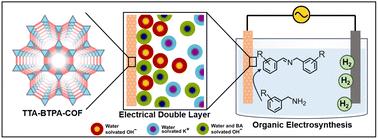解码共价有机框架中的化学结构-界面相关性,用于可持续有机电合成
IF 9.5
2区 材料科学
Q1 CHEMISTRY, PHYSICAL
引用次数: 0
摘要
共价有机骨架(COFs)是一类很有前途的下一代可持续催化剂。它们强健的骨架和可调的化学结构为它们提供了独特的物理化学特性。共轭COFs还表现出半导体性质,这使得它们适合于电荷和质量传递过程。这些特点使COFs成为电催化的有力候选者。然而,它们的电催化性能尚不清楚。特别是,人们对其界面结构和性质的了解有限,这阻碍了它们的广泛应用。为了解决这些问题,我们在此报告了共轭的、高多孔的cof电极,利用平行阴极产氢的苯胺衍生物氧化作为模型电催化系统。我们研究了催化剂-介质界面的结构,并研究了其电位依赖的电容和阻抗行为。通过调整COF的物理化学结构,我们确定了衬底和电极之间的operando氢键和表面吸附相互作用,这些相互作用影响了整体电催化性能。这是首个概念验证研究,确立了COFs作为可持续电催化剂的有效性,并强调了其物理化学调节在控制催化活性中的作用。本文章由计算机程序翻译,如有差异,请以英文原文为准。

Decoding chemical structure–interface correlation in covalent organic framework for sustainable organic electrosynthesis
Covalent Organic Frameworks (COFs) are a promising class of next-generation sustainable catalysts. Their robust backbones and tunable chemical structures offer them unique physicochemical properties. Conjugated COFs also show semiconducting behavior, which makes them suitable for charge and mass transfer processes. These features position COFs as strong candidates for electrocatalysis. However, their electrocatalytic performance is not yet well understood. In particular, there is limited knowledge about their interfacial structure and properties, which hinders their broader application. We herein report conjugated, highly porous COF-electrodes to address these issues, using the oxidation of benzylamine derivatives coupled with parallel cathodic hydrogen production as a model electrocatalytic system. We investigated the structure of the catalyst–medium interface and studied its potential-dependent capacitive and impedance behavior. By tuning the COF's physicochemical structure, we identified operando hydrogen bonding and surface adsorption interactions between the substrates and electrodes, which impacted the overall electrocatalytic performance. This first-of-its-kind, proof-of-concept study establishes the effectiveness of COFs as sustainable electrocatalysts and highlights the role of their physicochemical tuning in controlling the catalytic activities.
求助全文
通过发布文献求助,成功后即可免费获取论文全文。
去求助
来源期刊

Journal of Materials Chemistry A
CHEMISTRY, PHYSICAL-ENERGY & FUELS
CiteScore
19.50
自引率
5.00%
发文量
1892
审稿时长
1.5 months
期刊介绍:
The Journal of Materials Chemistry A, B & C covers a wide range of high-quality studies in the field of materials chemistry, with each section focusing on specific applications of the materials studied. Journal of Materials Chemistry A emphasizes applications in energy and sustainability, including topics such as artificial photosynthesis, batteries, and fuel cells. Journal of Materials Chemistry B focuses on applications in biology and medicine, while Journal of Materials Chemistry C covers applications in optical, magnetic, and electronic devices. Example topic areas within the scope of Journal of Materials Chemistry A include catalysis, green/sustainable materials, sensors, and water treatment, among others.
 求助内容:
求助内容: 应助结果提醒方式:
应助结果提醒方式:


